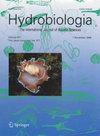Description of physical functionality in the coral reefs of Isla Espíritu Santo, La Paz, Baja California Sur
IF 0.3
4区 生物学
Q4 MARINE & FRESHWATER BIOLOGY
引用次数: 0
Abstract
Background. Corals play a fundamental role in reef structure and function because of their ability to deposit calcium carbonate and contribute to the formation of complex three-dimensional structures. However, the functioning potential of a reef community, in terms of its building capacity, is affected by the relative abundance of coral species on the reef. Objectives. Evaluate the physical functionality of coral reefs at six sites in the Parque Nacional Zona Marina del Archipiélago Espíritu Santo (PNZMAES). Methods. The Reef Functional Index (RFI) was implemented as a metric of physical functionality; this tool considers the calcification rate, structural complexity, and abundance of coral species at each site. Results. Las Navajas and San Gabriel sites had the highest coral cover, with 74.72 % and 60.14 %, respectively, while La Ballena was the site with the lowest coral cover (6.77 %). In terms of IFA, the sites with the highest index were Las Navajas (0.68) and San Gabriel (0.65), dominated by Pocillopora meandrina and Pocillopora verrucosa corals, respectively. The site with the lowest IFA was La Ballena (0.35), with Pocillopora verrucosa being the predominant coral. Coral species of the genus Pocillopora were predominant in all sites and contributed the most to the Reef Function Index. Conclusions. The Reef Function Index helped to complement the information on the coral assemblage in the PNZMAES and to understand the performance of coral species in the reef functioning of the Mexican Pacific.描述在圣岛Espíritu珊瑚礁的物理功能,拉巴斯,下加利福尼亚南部
背景。珊瑚具有沉积碳酸钙的能力,并有助于形成复杂的三维结构,因此在珊瑚礁的结构和功能中起着重要作用。然而,珊瑚礁群落的功能潜力,就其建筑能力而言,受到珊瑚礁上珊瑚种类相对丰富程度的影响。目标。评估位于archipisamlago Espíritu Santo国家滨海公园(PNZMAES)的六个地点的珊瑚礁的物理功能。方法。实施珊瑚礁功能指数(RFI)作为物理功能的度量标准;该工具考虑钙化率、结构复杂性和每个地点珊瑚物种的丰度。结果。Las Navajas和San Gabriel的珊瑚覆盖率最高,分别为74.72%和60.14%,La Ballena的珊瑚覆盖率最低,为6.77%。IFA指数最高的是Las Navajas(0.68)和San Gabriel(0.65),分别以poillopora meandrina和poillopora verrucosa珊瑚为主。IFA最低的生境为La Ballena(0.35),优势生境为疣状珊瑚虫(Pocillopora verrucosa)。所有样点的珊瑚种类均以poillopora属居多,对珊瑚礁功能指数的贡献最大。结论。珊瑚礁功能指数有助于补充PNZMAES中关于珊瑚组合的信息,并有助于了解墨西哥太平洋珊瑚礁功能中珊瑚物种的表现。
本文章由计算机程序翻译,如有差异,请以英文原文为准。
求助全文
约1分钟内获得全文
求助全文
来源期刊

Hidrobiologica
生物-海洋与淡水生物学
CiteScore
0.40
自引率
0.00%
发文量
8
审稿时长
>12 weeks
期刊介绍:
HIDROBIOLÓGICA es una publicación cuatrimestral que difunde trabajos originales e inéditos de investigación o revisión, sobre temas relacionados con los organismos y la hidrología de los ambientes acuáticos, dulces y marinos y va dirigida a investigadores de todo el mundo, interesados en las diversas disciplinas que incluye la Hidrobiología , así como a alumnos de posgrados y licenciaturas relacionados con la biología, ecología, taxonomía, filogenia y evolución de organismos acuáticos, e hidrología y oceanografía de ambientes s dulceacuícolas y marinos.
 求助内容:
求助内容: 应助结果提醒方式:
应助结果提醒方式:


